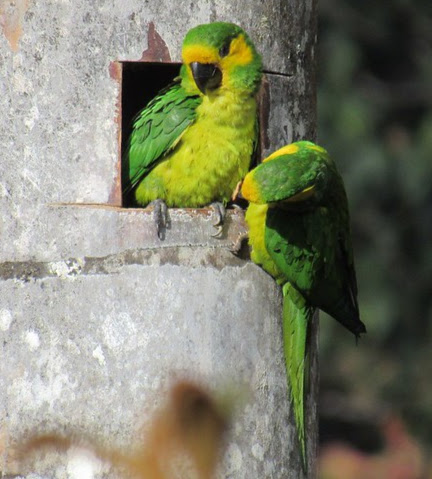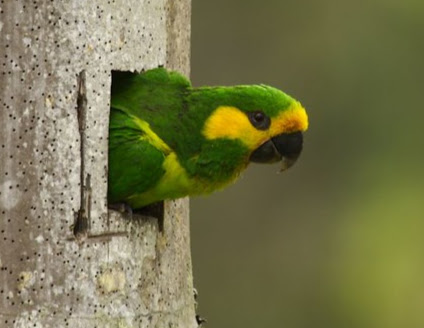Ognorrhynchus icterotis
Conservation action has prevented the global extinction of the Yellow-eared Parrot in Colombia, a study led by Newcastle University, UK and BirdLife International has shown.
Publishing their findings in the journal Conservation Letters, the team of scientists estimated the number of bird and mammal species that would have disappeared forever without the efforts of conservationists in recent decades. The researchers found that up to 32 bird and up to 7-16 mammal species extinctions have been prevented since 1993.

The study has highlighted the most frequent actions to prevent extinctions in these bird and mammal species and highlighted the single species success in Colombia – the Yellow-eared Parrot.
The research team, involving experts from BirdLife International, Sapienza University of Rome, Italy and the Zoological Society of London, among others, identified bird and mammal species that were listed as threatened on the International Union for the Conservation of Nature’s Red List.
Led by Dr Rike Bolam and Professor Phil McGowan, from Newcastle University’s School of Natural and Environmental Sciences, and Dr Stuart Butchart, Chief Scientist at BirdLife International, the team compiled information from 137 experts on the population size, trends, threats and actions implemented for the most threatened birds and mammals to estimate the likelihood that each species would have gone extinct without action. Their findings show that without conservation actions, extinction rates would have been around 3-4 times greater.
In 2019, Fundación ProAves published an extensive paper on the discovery of the last population of 81 individuals of the Yellow-eared Parrot that was on the brink of extinction. After two decades of conservation actions by ProAves together with many entities and communities, the species population today exceeds over 2,600 individuals.
Species for which extinction was prevented
Dr Rike Bolam from Newcastle University, lead author of the study, said: “It is encouraging that some of the species we studied have recovered very well. Our analyses therefore provide a strikingly positive message that conservation has substantially reduced extinction rates for birds and mammals. While extinctions have also occurred over the same time period, our work shows that it is possible to prevent extinctions.”
Professor Phil McGowan at Newcastle University, added: “While this is a glimmer of hope – that if we take action we can prevent the irreversible loss of the last individuals of a species – we mustn’t forget that in the same period, 15 bird and mammal species went extinct or are strongly suspected to have gone extinct.
Sara Inés Lara, Executive Director of Fundación ProAves notes: “At a time when the biodiversity crisis and extinction is plaguing our planet, an international team of science experts verified that with swift action we can prevent extinction. And I am proud that ProAves saved the sole species at imminent risk of extinction in Colombia, but our joy is tempered with the knowledge that an unprecedented number of unique and spectacular species in Colombia are fast approaching extinction. This important paper is a call to action to prove that we can prevent extinction if we act now to support conservation.”

Reference:
Bolam, F.C, et al. (2020). How many bird and mammal extinctions has recent conservation action prevented? Conservation Letters, e12762. doi: https://doi.org/10.1111/conl.12762 https://www.biorxiv.org/content/10.1101/2020.02.11.943902v1
